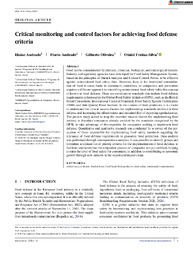Critical monitoring and control factors for achieving food defense criteria.
Critical monitoring and control factors for achieving food defense criteria.
Author(s): ANDRADE, E.; ANDRADE, F.; OLIVEIRA, G.; FREITAS-SILVA, O.
Summary: Food can be contaminated by physical, chemical, biological, and radiological hazards. Industry and regulatory agencies have developed the Food Safety Management System, based on the principles of Hazard Analysis and Critical Control Points, to be effective against unintentional food safety risks. However, there is the intentional contamination of food to cause harm to consumers, customers, or companies, and prevention requires a different approach to controlling unintentional food safety risks; this concept is known as food defense. There are certification standards that include food defense requirements referenced to the Global Food Safety Initiative (GFSI), such as the British Retail Consortium, International Featured Standards, Food Safety System Certification 22000, and Safe Quality Food Institute. In the context of food producers, it is crucial to understand the critical success factors for implementing standards involved in food defense and increasing the effectiveness and sustainability of exporting agroindustries. The present study aimed to map the essential success factors for implementing food defense in Brazilian companies already certified by the standards recognized by the GFSI, to take advantage of this expertise for companies seeking to implement food defense. Quantitative and qualitative research was conducted by a survey of the perception of those responsible for implementing food safety standards regarding the relevance of food defense requirements to guarantee food protection. Data analysis was performed through correspondence analysis. It was possible to identify groups and formulate a reduced list of priority criteria for the implementation of food defense, to facilitate and accelerate the adaptation process of companies not yet certified, helping to raise the level of food safety for consumers, in addition to contributing to economic growth through new entrants in the export and import chain.
Publication year: 2025
Types of publication: Journal article
Unit: Embrapa Food Technology
Observation
Some of Embrapa's publications are published as ePub files. To read them, use or download one of the following free software options to your computer or mobile device. Android: Google Play Books; IOS: iBooks; Windows and Linux: Calibre.
Access other publications
Access the Agricultural Research Database (BDPA) to consult Embrapa's full library collection and records.
Visit Embrapa Bookstore to purchase books and other publications sold by Embrapa.

